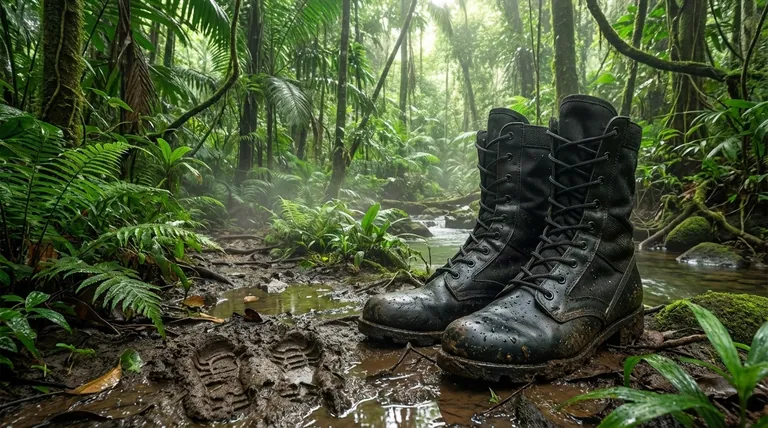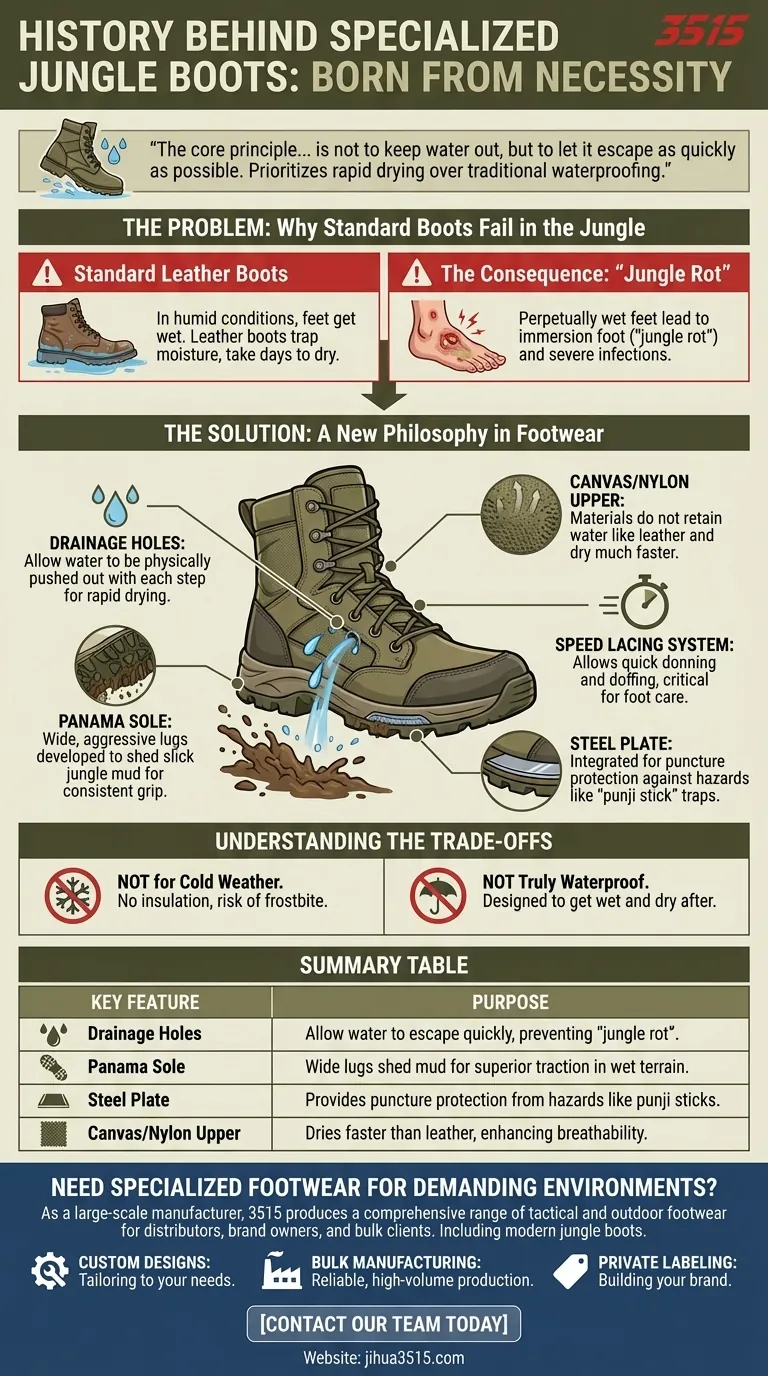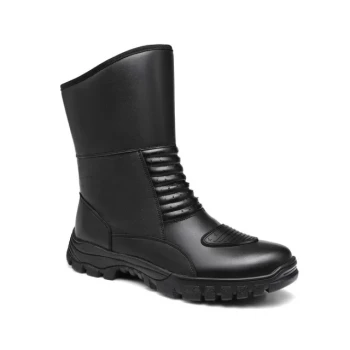The modern jungle boot was born from necessity. It originated in the mid-1940s as a direct response to the severe foot health problems soldiers faced in tropical and jungle environments. Its design was not an incremental improvement on standard footwear but a radical rethinking, refined through the harsh lessons learned by the U.S. military in places like Panama and, most notably, the Vietnam War.
The core principle behind the jungle boot is not to keep water out, which is impossible in a jungle, but to let it escape as quickly as possible. This design philosophy prioritizes rapid drying and foot health over traditional waterproofing.

The Problem: Why Standard Boots Fail in the Jungle
Before the specialized jungle boot, militaries deployed soldiers in standard-issue leather boots. In the humid, wet conditions of a jungle, this was a catastrophic failure that led to widespread medical issues.
The Inevitability of Wet Feet
In a tropical environment, feet get wet. This is a certainty due to constant rain, river crossings, and extreme humidity that causes profuse sweating.
Traditional leather boots, designed to be water-resistant, become a liability. Once soaked, they take days to dry, trapping moisture against the skin and creating a perfect breeding ground for bacteria and fungi.
The Consequence: "Jungle Rot"
The result of perpetually wet feet was a condition known as immersion foot, or "jungle rot." This painful affliction caused skin to break down, leading to severe infections that could render a soldier unable to walk, effectively removing them from the field as a casualty.
The military realized that preventing water from getting in was a losing battle. The only viable solution was to create a boot that could function while wet and dry out extremely quickly.
The Solution: A New Philosophy in Footwear
The evolution of the jungle boot centered on solving the problems of water retention, traction, and protection in a unique and hostile environment.
Embracing Water with Rapid Drainage
The most iconic feature of the jungle boot is its set of drainage holes or vents near the instep.
These metal eyelets allow water that floods the boot during a river crossing to be physically pushed out with each step the wearer takes. This simple mechanism dramatically accelerates the drying process.
Mastering Mud and Hazards
Jungle terrain is characterized by deep, slick mud. The classic "Panama" sole was developed with wide, aggressive lugs that were designed to shed mud instead of collecting it, ensuring a consistent grip.
Furthermore, a steel plate was integrated into the sole for puncture protection, a direct lesson from the Vietnam War to guard against sharpened "punji stick" traps.
Speed and Durability
The upper portion of the boot was typically made of canvas or nylon, materials that do not retain water like leather and dry much faster.
A speed lacing system, using a series of eyelets and hooks, allowed soldiers to don and doff the boots quickly, which was critical for both convenience and attending to foot care.
Understanding the Trade-offs
The jungle boot is a highly specialized piece of equipment. Its strengths in one environment become significant weaknesses in another.
Not for Cold Weather
The features that make jungle boots excel—breathability and water drainage—make them entirely unsuitable for cold climates. They offer virtually no insulation and will quickly lead to frostbite in cold, wet conditions.
Not Truly Waterproof
It is critical to understand that jungle boots are the opposite of waterproof. They are designed to get wet and will not keep your feet dry from external water sources like rain or puddles. Their purpose is to dry after getting soaked.
Making the Right Choice for Your Goal
Selecting the right footwear depends entirely on the environment you expect to face.
- If your primary focus is a hot, wet, or tropical environment: The jungle boot's rapid-drying and breathable design is specifically engineered for these conditions and remains an excellent choice.
- If your primary focus is cold or alpine conditions: Avoid the jungle boot entirely, as its lack of insulation and water resistance is dangerous in low temperatures.
- If your primary focus is general hiking in temperate climates: Modern hiking boots will likely offer a better balance of ankle support, cushioning, and weather resistance for your needs.
Ultimately, the history of the jungle boot is a lesson in designing for the reality of an environment, not an idealized version of it.
Summary Table:
| Key Feature | Purpose |
|---|---|
| Drainage Holes | Allow water to escape quickly, preventing "jungle rot". |
| Panama Sole | Wide lugs shed mud for superior traction in wet terrain. |
| Steel Plate | Provides puncture protection from hazards like punji sticks. |
| Canvas/Nylon Upper | Dries faster than leather, enhancing breathability. |
Need Specialized Footwear for Demanding Environments?
As a large-scale manufacturer, 3515 produces a comprehensive range of tactical and outdoor footwear for distributors, brand owners, and bulk clients. Our production capabilities encompass all types of specialized boots, including modern interpretations of jungle boots designed for durability, comfort, and performance.
We can help you with:
- Custom Designs: Tailoring footwear to your specific environmental and operational needs.
- Bulk Manufacturing: Reliable, high-volume production to meet your supply chain demands.
- Private Labeling: Building your brand with quality footwear manufactured by experts.
Let's discuss your project. Contact our team today to explore how we can bring your footwear requirements to life.
Visual Guide

Related Products
- Durable Military Combat Boots with Water Drainage for Wholesale & OEM
- Wholesale Tactical Boots High-Traction & Reflective for Bulk & Brand Orders
- Wholesale Waterproof Tactical Boots Custom Suede & High-Traction Soles
- Durable Leather High-Ankle Tactical Boots for Wholesale & Custom Manufacturing
- Durable Leather Tactical Boots Wholesale & Custom Manufacturing for Brands
People Also Ask
- How can a shiny finish be achieved on military boots? A Step-by-Step Guide to a Mirror Shine
- What has been the global recognition of fabric for over 30 years? Industry's Trusted Benchmark for Durability
- How do luxurious ostrich leather shoes differ from traditional dress shoes? A Guide to Texture & Comfort
- How did combat boots transition from military use to popular culture? From Battlefield to Fashion Statement
- What are the key features of the new Army Jungle Combat Boot? A Breakdown for Hot & Wet Environments



















